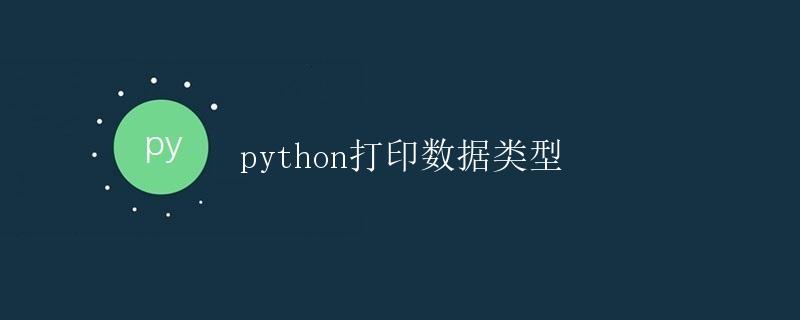Python打印数据类型

Python是一种简单而强大的编程语言,在处理数据时特别方便。它具有动态类型系统,这意味着在编写代码时,我们通常不需要明确指定变量的数据类型。然而,有时我们需要知道特定变量的数据类型。在这篇文章中,我们将详细介绍如何使用Python打印数据类型。
1. 数据类型简介
在Python中,有多种内置的数据类型,每个数据类型都有其特定的属性和方法。以下是Python中一些常见的数据类型:
- 数字(整数、浮点数、复数)
- 字符串
- 列表
- 元组
- 字典
- 集合
- 布尔类型(True和False)
这些数据类型可以用来表示不同类型的数据,并且可以在Python中进行操作。
2. 使用type()函数打印数据类型
Python中有一个内置的函数type(),可以用来查看变量的数据类型。我们可以使用type()函数来打印变量的数据类型。以下是使用type()函数打印各种数据类型的示例代码:
num = 10
print(type(num)) # <class 'int'>,整数类型
pi = 3.14
print(type(pi)) # <class 'float'>,浮点数类型
name = "John"
print(type(name)) # <class 'str'>,字符串类型
fruits = ["apple", "banana", "orange"]
print(type(fruits)) # <class 'list'>,列表类型
person = {"name": "John", "age": 30}
print(type(person)) # <class 'dict'>,字典类型
marks = (80, 85, 90)
print(type(marks)) # <class 'tuple'>,元组类型
is_student = True
print(type(is_student)) # <class 'bool'>,布尔类型
运行上述代码,将会得到以下输出:
<class 'int'>
<class 'float'>
<class 'str'>
<class 'list'>
<class 'dict'>
<class 'tuple'>
<class 'bool'>
通过使用type()函数,我们可以轻松地确定变量的数据类型。
3. 使用isinstance()函数打印数据类型
除了使用type()函数,Python还提供了另一个内置函数isinstance(),它可以更灵活地判断一个对象是否属于指定的数据类型。isinstance()函数接受两个参数,第一个参数是要检查的对象,第二个参数是待检查的数据类型。以下是使用isinstance()函数打印数据类型的示例代码:
num = 10
print(isinstance(num, int)) # True
pi = 3.14
print(isinstance(pi, float)) # True
name = "John"
print(isinstance(name, str)) # True
fruits = ["apple", "banana", "orange"]
print(isinstance(fruits, list)) # True
person = {"name": "John", "age": 30}
print(isinstance(person, dict)) # True
marks = (80, 85, 90)
print(isinstance(marks, tuple)) # True
is_student = True
print(isinstance(is_student, bool)) # True
运行上述代码,将会得到以下输出:
True
True
True
True
True
True
True
使用isinstance()函数,我们可以更灵活地判断一个对象是否属于指定的数据类型。
4. 自定义打印数据类型的函数
除了使用内置的type()和isinstance()函数,我们还可以自定义一个函数来打印变量的数据类型。下面是一个示例代码:
def print_data_type(var):
type_name = type(var).__name__
print(f"The data type of {var} is {type_name}")
num = 10
print_data_type(num) # The data type of 10 is int
pi = 3.14
print_data_type(pi) # The data type of 3.14 is float
name = "John"
print_data_type(name) # The data type of John is str
fruits = ["apple", "banana", "orange"]
print_data_type(fruits) # The data type of ['apple', 'banana', 'orange'] is list
person = {"name": "John", "age": 30}
print_data_type(person) # The data type of {'name': 'John', 'age': 30} is dict
marks = (80, 85, 90)
print_data_type(marks) # The data type of (80, 85, 90) is tuple
is_student = True
print_data_type(is_student) # The data type of True is bool
运行上述代码,将会得到以下输出:
The data type of 10 is int
The data type of 3.14 is float
The data type of John is str
The data type of ['apple', 'banana', 'orange'] is list
The data type of {'name': 'John', 'age': 30} is dict
The data type of (80, 85, 90) is tuple
The data type of True is bool
这个自定义的函数可以根据输入的变量打印出变量的数据类型。
结论
在Python中,通过使用type()函数、isinstance()函数或自定义函数,我们可以轻松地打印任意变量的数据类型。这对于调试代码、理解代码中的数据结构以及编写更健壮的程序非常重要。
 极客教程
极客教程